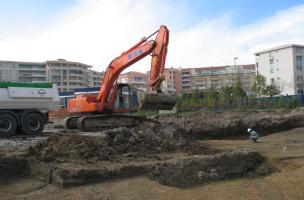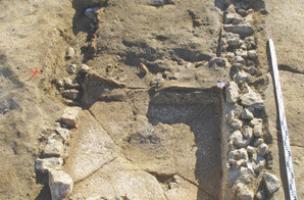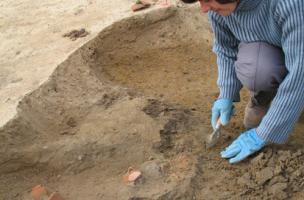Search
You are here
A Roman farm on the shore of the Antibes lagoon
A team from Inrap is at present digging on the shore of the Antibes lagoon. The site, not far from the heart of the antique agglomeration of Antipolis, is being excavated prior to the extension of the Bas-Lauvert Urban Development Zone, at Antibes-Juan-les-Pins.
Chronicle of site
Post date
28 March 2006
Last modified
10 February 2017
Given the location and the extent of the development project – more than 100,000 m2 – it is not surprising that there have been archaeological discoveries. Important antique remains (1st century B.C. – 2nd century A.D.) are being found during the excavation, which is curated by the State.
It is known that Antipolis's prosperity depended on both its fishing industry and its position on maritime commercial routes. Today, archaeologists are in a position to shed new light on both the exploitation of the lagoon and agricultural activity along the coast.
It is known that Antipolis's prosperity depended on both its fishing industry and its position on maritime commercial routes. Today, archaeologists are in a position to shed new light on both the exploitation of the lagoon and agricultural activity along the coast.
A coastal farm
A large enclosure was created at the beginning of the 1st century B.C. This type of structure, surrounded by ditches, was as yet unknown in the département of the Alpes Maritimes. The ditches contain all sorts of objects that had been thrown away: Italic and Punic amphorae, Campanian pottery, cups, pitchers and cooking pots of different origins.
The most substantial structure inside the enclosure is a large stone basin composed of two vats. Common in agricultural exploitations of the Roman province of Gallia Narbonensis, this was generally used in olive oil or wine production. The property limits are indicated by ditches. Plantation trenches and other traces of farming show that the domain was used for cultivation during the 1st century B.C. until the 2nd A.D.
The most substantial structure inside the enclosure is a large stone basin composed of two vats. Common in agricultural exploitations of the Roman province of Gallia Narbonensis, this was generally used in olive oil or wine production. The property limits are indicated by ditches. Plantation trenches and other traces of farming show that the domain was used for cultivation during the 1st century B.C. until the 2nd A.D.
The development of the lagoon
During the first two centuries AD, a considerable Roman construction was built in the lagoon: it consisted of a sturdy stone-built dyke, an embankment 2.50 metres wide, and a line of piles holding the banks in place. At the end of the lagoon, archaeologists have just cleared an antique floor paved with pebbles, 40 m wide and recognisable over a length of 200 metres. The exact function of this type of "calade" which was submerged during antiquity has yet to be discovered. A programme of palaeo-environmental research(pollen and charcoal analysis, etc.) will lead to a better understanding of the environment both of the lagoon and of the surrounding area.
Site Director : Isabelle Daveau, Inrap
Curation : Regional Archaeology Service (Drac of Provence-Alpes-Côte d'Azur)
Developers : Société Juan Flore-George V Côte d'Azur
Contact(s) :
Mahaut Tyrrell
Media communication
Inrap, media partnerships and relations
+33 6 07 40 59 77
mahaut.tyrrell [at] inrap.fr




